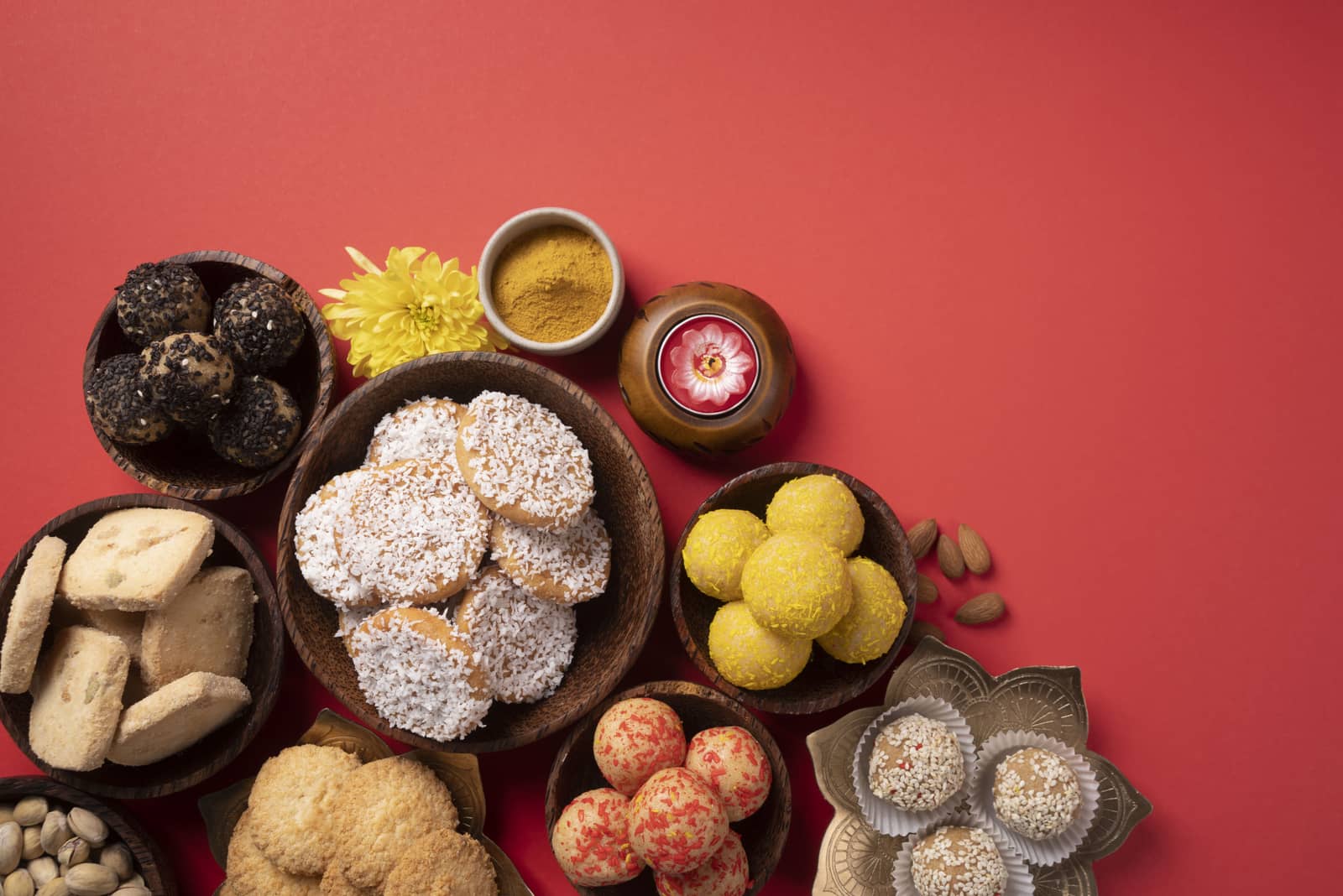
Traditional Indian Sweets for Diwali: Timeless Treats to Celebrate the Festival of Lights

Gagan Singh
Author
Updated at August 2, 2025
Diwali, also known as the Festival of Lights, is one of the most cherished celebrations in India. It symbolizes the victory of light over darkness and good over evil. And no Diwali is ever complete without the rich aroma of ghee-laden sweets wafting through homes. Across generations, families have passed down traditional mithai recipes, making sweet-making an integral part of the festival.
In this blog, we will explore the most loved Diwali mithai, understand the traditions behind these classic Indian sweets, and even discover how you can try your hand at making some of them at home.
The Significance of Sweets in Diwali
In Indian culture, sweets represent joy, purity, and auspiciousness. Diwali marks new beginnings, and offering sweets to gods and loved ones is believed to bring prosperity.
During the five days of Diwali, sweet-making becomes a family affair. From preparing festival sweets together to exchanging them with neighbours, sweets are not just food—they are a symbol of love, unity, and tradition.
15 Must-Have Traditional Indian Sweets for Diwali
Here are some timeless classic Indian sweets that remain essential during Diwali celebrations:
1. Ladoo
A staple of every Indian festival, ladoo comes in many variations like besan ladoo, motichoor ladoo, rava ladoo, and boondi ladoo. Rich in ghee and often garnished with nuts, they are round, flavorful, and melt-in-the-mouth.
2. Kaju Katli
Made from cashew nuts and sugar, this diamond-shaped sweet is delicate and smooth. Often adorned with silver vark (foil), kaju katli is one of the most gifted Diwali mithai.
3. Barfi
From milk barfi to pista barfi, this dense, fudge-like sweet is a classic found in most Indian sweets shops in Singapore.
4. Gulab Jamun
Soft, syrupy, and indulgent, gulab jamun are deep-fried dough balls made from khoya or milk powder and soaked in rose-scented sugar syrup.
5. Rasgulla
Spongy and light, rasgullas are a Bengali delight made from chhena (fresh cheese) and soaked in sugar syrup. They’re best served chilled.
6. Jalebi
Crunchy on the outside and syrupy inside, jalebi is made by deep-frying flour batter in circular shapes and soaking them in saffron syrup. It’s one of the most popular festival sweets.
7. Soan Papdi
This flaky, cube-shaped sweet is made from gram flour, ghee, and sugar. It has a delicate, airy texture and is often found in festive gift boxes.
8. Churma Ladoo
A Rajasthani specialty, churma ladoo is made from crushed wheat rotis mixed with jaggery and ghee. It’s nutritious and delicious.
9. Peda
A sweet treat from Mathura, peda is made using khoya, cardamom, and sugar. It has a rich texture and is often offered to deities during puja.
10. Sandesh
A Bengali sweet made from fresh paneer, sandesh is light, mildly sweet, and sometimes flavored with saffron or cardamom.
11. Kalakand
Prepared by reducing milk until it thickens, kalakand has a moist, grainy texture and a rich milky taste.
12. Mysore Pak
This South Indian delight is made using gram flour, sugar, and ghee. It’s rich, dense, and known for its melt-in-the-mouth quality.
13. Halwa
From suji halwa (semolina) to moong dal halwa and gajar halwa (carrot), halwa is a versatile sweet served hot and rich with dry fruits.
14. Imarti
Often confused with jalebi, imarti is thicker and made from urad dal batter. It has a unique flavor and firm texture.
15. Malpua
A festive pancake-like sweet, malpua is soaked in syrup and sometimes served with rabri (sweet condensed milk).
For a sweet guide on where to enjoy these delicacies, explore Akasa's blog on Indian sweet dessert options in Singapore.
Regional Variations in Diwali Mithai
India’s diversity means that every region has its own unique Diwali sweets:
- North India: Kaju katli, besan ladoo, and gulab jamun dominate the scene.
- South India: Mysore pak, adhirasam, and coconut burfi are festive favorites.
- West India: Gujarat and Maharashtra feature sweets like shrikhand, modak, and basundi.
- East India: Bengali sweets like sandesh and rasgulla are household staples.
These regional flavors ensure that every home has its unique blend of traditional mithai recipes.
Easy Traditional Mithai Recipes to Try at Home
Want to make your own Diwali mithai this year? Here are 3 simple recipes:
1. Besan Ladoo Recipe
Ingredients:
- 1 cup besan (gram flour)
- ½ cup ghee
- ¾ cup powdered sugar
- ¼ tsp cardamom powder
- Chopped almonds (optional)
Instructions:
Roast besan in ghee on low heat until golden and fragrant.
Let it cool slightly, then add sugar and cardamom.
Mix and shape into balls. Garnish with almonds.
2. Kaju Katli Recipe
Ingredients:
- 1 cup cashews (powdered)
- ½ cup sugar
- ¼ cup water
- A few drops of rose water or cardamom powder
Instructions:
Make sugar syrup with sugar and water until it reaches one-thread consistency.
Add cashew powder and cook till it forms a dough.
Roll the mixture and cut into diamonds.
3. Coconut Barfi Recipe
Ingredients:
- 2 cups grated coconut (fresh or desiccated)
- 1 cup condensed milk
- 1 tsp ghee
- Cardamom powder
Instructions:
Mix coconut and condensed milk in a pan.
Cook on medium heat until it thickens.
Pour into a greased tray and cut into squares.
Healthier Alternatives for Festival Sweets
While traditional sweets are rich and indulgent, you can make healthier versions too:
- Use jaggery instead of white sugar.
- Replace full-fat milk with almond or coconut milk.
- Bake or air-fry certain sweets instead of deep-frying.
- Use dry fruits and dates to naturally sweeten dishes.
These health-friendly Diwali mithai options are especially suitable for modern eaters. For healthy yet tasty meal options, check out Akasa's blog on health food restaurants in Singapore.
How to Store and Serve Diwali Sweets
Proper storage ensures your sweets remain fresh and safe to eat:
- Keep milk-based sweets like rasgulla and peda refrigerated and consume within 2-3 days.
- Dry sweets like ladoo and barfi can be stored in airtight containers at room temperature.
- Always use dry spoons and avoid moisture.
Serve sweets in decorative trays or brass thalis to enhance the festive vibe.
Modern Takes on Classic Indian Sweets
Today’s chefs are giving traditional sweets a modern twist:
- Chocolate Gulab Jamun
- Kesar Pista Cheesecake Barfi
- Thandai Truffle Ladoo
- Fusion Halwa Cups
These creative versions are especially popular among the younger generation and make great festival sweets for Diwali parties.
Buying the Best Diwali Mithai in Singapore
If you're in Singapore and want authentic Indian sweets, Akasa offers a luxurious and traditional experience with handcrafted Diwali mithai boxes and catering for festive events.
Explore:
- Akasa Festival Catering
- Indian Sweets Singapore
Order early, especially during peak Diwali season, as fresh mithai sells fast!
Gifting Festival Sweets: Tips and Ideas
Diwali is also a time to share. Gifting sweets is a way of expressing good wishes. Here’s how to make your gift stand out:
- Choose a mix of traditional and fusion sweets.
- Go for personalised sweet boxes with names or messages.
- Add dry fruits, diyas, or incense sticks to your gift box.
- Pick sweets with a longer shelf life for outstation delivery.
Whether you're gifting family, friends, or colleagues, nothing beats the warmth of Diwali mithai.
Conclusion
Traditional Indian sweets are more than just desserts. They represent culture, memory, and the essence of celebration. From rolling ladoos with your grandmother to receiving a box of kaju katli from a friend, festival sweets have a magical way of connecting people.
Whether you make them at home using traditional mithai recipes or buy them from your favorite sweet shop, don’t forget to indulge in the sweetness of the season.
This Diwali, let your celebrations be bright, joyful, and full of classic Indian sweets that tell a story of heritage and happiness.
Related Blogs:
Tanjong Pagar bar | Indian vegetarian restaurant Singapore | Lau Pa Sat food | Dinner ideas Singapore | Best butter chicken Singapore | Cheap food in Orchard | Cheap brunch Singapore | Affordable restaurants with a view Singapore | Best restaurants for Valentine's Day | Affordable family restaurants Singapore | Indian sweet dessert | Popular restaurants in Singapore | Health food restaurants | Best Indian buffet Singapore | Best affordable Indian restaurants in Singapore | Best Fine Dining Restaurants in Singapore | Healthy Indian food | North vs South Indian food
Frequently Asked Questions
Some of the most popular Diwali mithai include ladoos, kaju katli, gulab jamun, barfi, jalebi, and soan papdi. These classic Indian sweets are enjoyed across regions and often gifted during the festival.
Sweets symbolise joy, prosperity, and the spirit of giving. Sharing festival sweets during Diwali strengthens bonds with family and friends and is considered an auspicious tradition.
Yes, many traditional mithai recipes like besan ladoo, coconut barfi, and kaju katli are simple and can be made at home with basic ingredients like ghee, sugar, and flour or nuts.
Milk-based sweets like rasgulla or peda should be refrigerated and consumed within 2-3 days. Dry sweets like ladoo and barfi can be stored in airtight containers at room temperature for up to a week.
You can use jaggery instead of refined sugar, and opt for natural ingredients like dates, nuts, and oats. Dry fruit ladoos, coconut-date rolls, and baked mithai are some healthier festival sweets options.
You can order high-quality, handcrafted Diwali sweets in Singapore from Akasa.sg. They offer a wide range of traditional and modern Indian sweets, with convenient delivery options.
Kaju katli, soan papdi, barfi, and dry fruit ladoos are ideal for gifting as they have longer shelf lives and are widely loved. You can also go for assorted mithai gift boxes for variety.
Yes, classic Indian sweets vary by region. For example, Mysore pak is popular in South India, rasgulla and sandesh in the East, and peda and gulab jamun in North India. Each region brings unique flavors to the celebration.
Absolutely. Vegan versions of traditional mithai recipes use coconut oil instead of ghee and plant-based milk. Many sweets like coconut barfi and dry fruit ladoos are naturally dairy-free.
Most people start making festival sweets 3–5 days before Diwali, so they are fresh for the celebrations. Preparing in advance also allows time for gifting and puja offerings.
